Analysis and Design of a Diplexing Power Divider for Ku-Band Satellite Applications
Abstract
:1. Introduction
2. Geometry of the Proposed Diplexing Structure and Performance Analysis
2.1. Overall Structure
2.2. Analysis
3. Diplexing-Power Divider: Design and Performance
4. Conclusions
Author Contributions
Funding
Institutional Review Board Statement
Informed Consent Statement
Data Availability Statement
Acknowledgments
Conflicts of Interest
References
- Rohaninezhad, M.; Asadabadi, M.J.; Ghobadi, C.; Nourinia, J. Design and fabrication of a super-wideband transparent antenna implanted on a solar cell substrate. Sci. Rep. 2023, 13, 9977. [Google Scholar] [CrossRef] [PubMed]
- Ghayekhloo, A.; Akbari, M.; Afsahi, M.; Orouji, A.A.; Sebak, A.R.; Denidni, T.A. Multifunctional transparent electromagnetic surface based on solar cell for backscattering reduction. IEEE Trans. Antennas Propag. 2019, 67, 4302–4306. [Google Scholar] [CrossRef]
- Zarbakhsh, S.; Akbari, M.; Farahani, M.; Ghayekhloo, A.; Denidni, T.A.; Sebak, A. Optically transparent subarray antenna based on solar panel for CubeSat application. IEEE Trans. Antennas Propag. 2019, 68, 319–328. [Google Scholar] [CrossRef]
- Zarbakhsh, S.; Sebak, A.R. Multifunctional drone-based antenna for satellite communication. IEEE Trans. Antennas Propag. 2022, 70, 7223–7227. [Google Scholar] [CrossRef]
- Wang, X.; Wang, J.; Zhang, G.; Hong, J.S.; Wu, W. Dual-wideband filtering power divider with good isolation and high selectivity. IEEE Microw. Wirel. Compon. Lett. 2017, 27, 1071–1073. [Google Scholar] [CrossRef]
- Wu, L.; Yilmaz, H.; Bitzer, T.; Berroth, A.P.M. A dual-frequency Wilkinson power divider: For a frequency and its first harmonic. IEEE Microw. Wirel. Compon. Lett. 2005, 15, 107–109. [Google Scholar] [CrossRef]
- Psychogiou, D.; Gómez-García, R.; Guyette, A.C.; Peroulis, D. Reconfigurable Single/Multi-Band Filtering Power Divider Based on Quasi-Bandpass Sections. IEEE Microw. Wirel. Compon. Lett. 2016, 26, 684–686. [Google Scholar] [CrossRef]
- Guo, L.; Zhu, H.; Abbosh, A.M. Wideband Tunable In-Phase Power Divider Using Three-Line Coupled Structure. IEEE Microw. Wirel. Compon. Lett. 2016, 26, 404–406. [Google Scholar] [CrossRef]
- Chiu, L.; Xue, Q. A Parallel-Strip Ring Power Divider with High Isolation and Arbitrary Power-Dividing Ratio. IEEE Trans. Microw. Theory Tech. 2007, 55, 2419–2426. [Google Scholar] [CrossRef]
- Zhai, W.; Miraftab, V.; Boutayeb, H. Millimeter Wave Dual-Mode Diplexer and Method. U.S. Patent US 9,660,316, 23 May 2017. [Google Scholar]
- Mukherjee, S.; Biswas, A. Design of Self-Diplexing Substrate Integrated Waveguide Cavity-Backed Slot Antenna. IEEE Antennas Wirel. Propag. Lett. 2016, 15, 1775–1778. [Google Scholar] [CrossRef]
- James, G.L.; Clark, P.R.; Greene, K.J. Diplexing feed assemblies for application to dual-reflector antennas. IEEE Trans. Antennas Propag. 2003, 51, 1024–1029. [Google Scholar] [CrossRef]
- Zarbakhsh, M.A.M.K.S.; Gholami, R. A Simple UWB Antenna with Dual Stop-Band Performance Using Rectangular Slot and Strip Line Ended Up Shorting PIN. Prog. Electromagn. Res. C 2013, 42, 83–94. [Google Scholar]
- Zhang, D.; Yang, B.; Li, G.; Shao, L. The Control System of One Space Probe Small Satellite. In Spacecraft Guidance, Navigation Control Systems; NASA: Washington, DC, USA, 2000; Volume 425, p. 49. [Google Scholar]
- Islam, M.T.; Cho, M.; Samsuzzaman, M.; Kibria, K. Compact antenna for small satellite applications Antenna Applications Corner. IEEE Antennas Propag. Mag. 2015, 57, 30–36. [Google Scholar] [CrossRef]
- Rohaninezhad, M.; Ghayekhloo, A.; Afsahi, M.; Denidni, T.A. Design of a transparent system for mutual coupling reduction of microstrip array antennas with confined water. Phys. Status Solidi A 2022, 219, 2200082. [Google Scholar] [CrossRef]
- Ofli, E.; Vahldieck, R.; Amari, S. Novel E-plane filters and diplexers with elliptic response for millimeter-wave applications. IEEE Trans. Microw. Theory Tech. 2005, 53, 843–851. [Google Scholar] [CrossRef]
- Rebollar, J.M.; Montejo-Garai, J.R.; Ohoro, A. Asymmetric H-plane T-junction for broadband diplexer applications. In Proceedings of the IEEE Antennas and Propagation Society International Symposium. Transmitting Waves of Progress to the Next Millennium. 2000 Digest. Held in Conjunction with: USNC/URSI National Radio Science Meeting, Salt Lake City, UT, USA, 16–21 July 2000; IEEE: Piscataway, NJ, USA, 2000; Volume 4, pp. 2032–2035. [Google Scholar]
- Chakraborty, A.; Dwari, S. Analysis of Field Propagation inside A Waveguide Diplexer using Cavity Model Analysis. Int. J. Adv. Microw. Technol. 2023, 8, 296–300. [Google Scholar] [CrossRef]
- Roshani, S.; Yahya, S.I.; Mezaal, Y.S.; Chaudhary, M.A.; Al-Hilali, A.A.; Mojirleilani, A.; Roshani, S. Design of a Compact Quad-Channel Microstrip Diplexer for L and S Band Applications. Micromachines 2023, 14, 553. [Google Scholar] [CrossRef]
- Teberio, F.; Arregui, I.; Soto, P.; Laso, M.A.; Boria, V.E.; Guglielmi, M. High-performance compact diplexers for Ku/K-band satellite applications. IEEE Trans. Microw. Theory Tech. 2017, 65, 3866–3876. [Google Scholar] [CrossRef]
- Lin, Y.; You, Y.; Shen, S.; Huang, J.; Lu, Y. A K-/Ka-Band Diplexer-Integrated Simplified Rotary Joint Using Gap Waveguide Technology. IEEE Microw. Wirel. Technol. Lett. 2023, 33, 1139–1142. [Google Scholar] [CrossRef]
- Shen, T.; Zaki, K.A.; Dolan, T.G. Rectangular waveguide diplexers with a circular waveguide common port. IEEE Trans. Microw. Theory Tech. 2003, 51, 578–582. [Google Scholar] [CrossRef]
- Zhao, X.; Gao, L.; Zhang, X.Y.; Xu, J. Novel filtering power divider with wide stopband using discriminating coupling. IEEE Microw. Wirel. Compon. Lett. 2016, 26, 580–582. [Google Scholar] [CrossRef]
- Amn-E-Elahi, A.; Rezaei, P.; Karami, F.; Hyjazie, F.; Boutayeb, H. Analysis and Design of a Stacked PCBs-Based Quasi-Helix Antenna. IEEE Trans. Antennas Propag. 2022, 70, 12253–12257. [Google Scholar] [CrossRef]
- Amn-e-Elahi, A.; Karami, F.; Rezaei, P.; Boutayeb, H.; Hyjazie, F.; Talbi, L. A Sequentially Rotated 2×2 Helix Antenna Array. In Proceedings of the IEEE International Symposium Antennas Propagation-USNC-URSI Radio Science Meeting (AP-S/URSI), Denver, CO, USA, 10–15 July 2022; pp. 371–372. [Google Scholar]
- Tang, C.; You, S. Design methodologies of LTCC bandpass filters, diplexer, and triplexer with transmission zeros. IEEE Trans. Microw. Theory Tech. 2006, 54, 717–723. [Google Scholar] [CrossRef]
- Xu, J.-X.; Zhang, X.Y. Compact high-isolation LTCC diplexer using common stub-loaded resonator with controllable frequencies and bandwidths. IEEE Trans. Microw. Theory Tech. 2017, 65, 4636–4644. [Google Scholar] [CrossRef]
- Chen, D.; Zhu, L.; Bu, H.; Cheng, C. A novel planar diplexer using slotline-loaded microstrip ring resonator. IEEE Microw. Wirel. Compon. Lett. 2015, 25, 706–708. [Google Scholar] [CrossRef]
- Ebrahimzadeh, R.; Mousavipour, M.; Yazdi, M.; Darvish, A. Stub-Based 6–18 GHz UWB Filter with Very Steep Rolloff for Radar Measurement Systems. In Proceedings of the IEEE International Symposium Antennas Propagation—North American Radio Science Meeting, Montreal, QC, Canada, 5–10 July 2020; pp. 1461–1462. [Google Scholar]
- Deng, P.; Liu, R.; Lin, W.; Lo, W. Design of a microstrip low-pass-bandpass diplexer using direct-feed coupled-resonator filter. IEEE Microw. Wirel. Compon. Lett. 2017, 27, 254–256. [Google Scholar] [CrossRef]
- Karami, F.; Rezaei, P.; Amn-e-Elahi, A.; Sharifi, M.; Meiguni, J.S. Efficient transition hybrid two-layer feed network: Polarization diversity in a satellite transceiver array antenna. IEEE Antennas Propag. Mag. 2021, 63, 51–60. [Google Scholar] [CrossRef]
- Karami, F.; Rezaei, P.; Amn-e-Elahi, A.; Mousavirazi, Z.; Denidni, T.A.; Kishk, A.A. A compact high-performance patch array with suppressed cross polarization using image feed configuration. AEU Int. J. Electron. Commun. 2020, 127, 153479. [Google Scholar] [CrossRef]
- Karami, F.; Boutayeb, H.; Amn-e-Elahi, A.; Ghayekhloo, A.; Talbi, L. Developing broadband microstrip patch antennas fed by SIW feeding network for spatially low cross-polarization situation. Sensors 2022, 22, 3268. [Google Scholar] [CrossRef]
- Diman, A.A.; Karami, F.; Rezaei, P.; Amn-e-Elahi, A.; Mousavirazi, Z.; Denidni, T.A.; Kishk, A.A. Efficient SIW-feed network suppressing mutual coupling of slot antenna array. IEEE Trans. Antennas Propag. 2021, 69, 6058–6063. [Google Scholar] [CrossRef]
- Chen, R.S.; Wong, S.-W.; Zhu, L.; Chu, Q.-X. Wideband bandpass filter using u-slotted substrate integrated waveguide (SIW) cavities. IEEE Microw. Wirel. Compon. Lett. 2015, 25, 532–534. [Google Scholar] [CrossRef]
- Ebrahimzadeh, R.; Zakeri, B.; Yousefzadeh, M.; Hosseininejad, S.E. Optically Controlled Reconfigurable Substrate Integrated Waveguide Slot Array Antenna for 5G Applications. In Proceedings of the 10th International Symposium Telecommunications (IST), Tehran, Iran, 15–17 December 2020; pp. 107–110. [Google Scholar]
- Kiani, S.; Rezaei, P. Microwave Substrate Integrated Waveguide Resonator Sensor for Non-Invasive Monitoring of Blood Glucose Concentration: Low Cost and Painless Tool for Diabetics. Measurement 2023, 219, 113232. [Google Scholar] [CrossRef]
- Chen, C.; Lin, C.; Tseng, B.; Chang, S. High-isolation and high-rejection microstrip diplexer with independently controllable transmission zeros. IEEE Microw. Wirel. Compon. Lett. 2014, 24, 851–853. [Google Scholar] [CrossRef]
- Hagag, M.F.; Khater, M.A.; Hickle, M.D.; Peroulis, D. Tunable SIW cavity-based dual-mode diplexers with various single-ended and balanced ports. IEEE Trans. Microw. Theory Tech. 2018, 66, 1238–1248. [Google Scholar] [CrossRef]
- Segura-Gómez, C.; Palomares-Caballero, Á.; Alex-Amor, A.; Valenzuela-Valdés, J.; Padilla, P. Modular design for a stacked SIW antenna array at Ka-band. IEEE Access 2020, 8, 158568–158578. [Google Scholar] [CrossRef]
- Hautcoeur, J.; Ghayekhloo, A.; Hettak, K.; Talbi, L.; Boutayeb, H.; Wu, K. 60 GHz frequency sensor antenna for short-range millimeter-wave detection application. IEEE Sens. Lett. 2022, 6, 3502304. [Google Scholar] [CrossRef]
- Duong, T.V.; Hong, W.; Hao, Z.C.; Huang, W.C.; Zhuang, J.X.; Vo, V.P. A millimeter wave high-isolation diplexer using selectivity improved dual-mode filters. IEEE Microw. Wirel. Compon. Lett. 2016, 26, 104–106. [Google Scholar] [CrossRef]
- Song, K.; Zhou, Y.; Chen, Y.; Iman, A.M.; Patience, S.R.; Fan, Y. High-isolation diplexer with high frequency selectivity using substrate integrate waveguide dual-mode resonator. IEEE Access 2019, 7, 116676–116683. [Google Scholar] [CrossRef]
- Boutayeb, H. Reconfigurable Radial Waveguides with Switchable Artificial Magnetic Conductors. U.S. Patent US 10,903,569, 26 January 2021. [Google Scholar]
- Vosoogh, A.; Sorkherizi, M.S.; Zaman, A.U.; Yang, J.; Kishk, A.A. An integrated Ka-Band diplexer-antenna array module based on gap waveguide technology with simple mechanical assembly and no electrical contact requirements. IEEE Trans. Microw. Theory Tech. 2018, 66, 962–972. [Google Scholar] [CrossRef]
- Sorkherizi, M.; Vosoogh, A.; Kishk, A.A.; Kidal, P.S. Design of integrated diplexer-power divider. In Proceedings of the IEEE MTT-S International Microwave Symposium, IMS, San Francisco, CA, USA, 22–27 May 2016. [Google Scholar]
- Karami, F.; Boutayeb, H.; Talbi, L. Directive Millimeter-Wave End-Fire Diplexing Antenna for IoT Applications. IEEE Internet Things J. 2023. [Google Scholar] [CrossRef]
- Karami, F.; Boutayeb, H.; Talbi, L. IoT-based Transceiver Antenna System for 5G Future High-Speed Train Communications. In Proceedings of the 17th European Conference on Antennas and Propagation (EuCAP), Florence, Italy, 26–31 March 2023; pp. 1–3. [Google Scholar]
- Kumar, A.; Chaturvedi, D.; Raghavan, S. Dual-Band, Dual-Fed Self-Diplexing Antenna. In Proceedings of the 13th European Conference Antennas Propagation (EuCAP), Krakow, Poland, 31 March–5 April 2019; pp. 1–5. [Google Scholar]
- Vosoogh, A.; Zaman, A.U.; Yang, J.; Sharifi, M.; Kishk, A. An E-band antenna-diplexer compact integrated solution based on gap waveguide technology. In Proceedings of the IEEE International Symposium on Antennas and Propagation, San Diego, CA, USA, 9–14 July 2017; pp. 1–2. [Google Scholar]
- Zhang, G.; Qian, Z.; Yang, J. Design of a compact microstrip power-divider diplexer with simple layout. Electron. Lett. 2018, 54, 1007–1009. [Google Scholar] [CrossRef]
- Deng, P.H.; Lo, W.; Chen, B.L.; Lin, C.H. Designs of diplexering power dividers. IEEE Access 2018, 6, 3872–3881. [Google Scholar] [CrossRef]
- Erkelenz, K.; Meyer, L.; Sielck, N.; Deutschmann, B.; Jacob, A.F. A Compact K-/Ka-Band Waveguide Transition with Integrated Diplexer and Power Divider. In Proceedings of the 2021 51st European Microwave Conference (EuMC), London, UK, 4–6 April 2021; IEEE: Piscataway, NJ, USA, 2022; pp. 95–98. [Google Scholar]
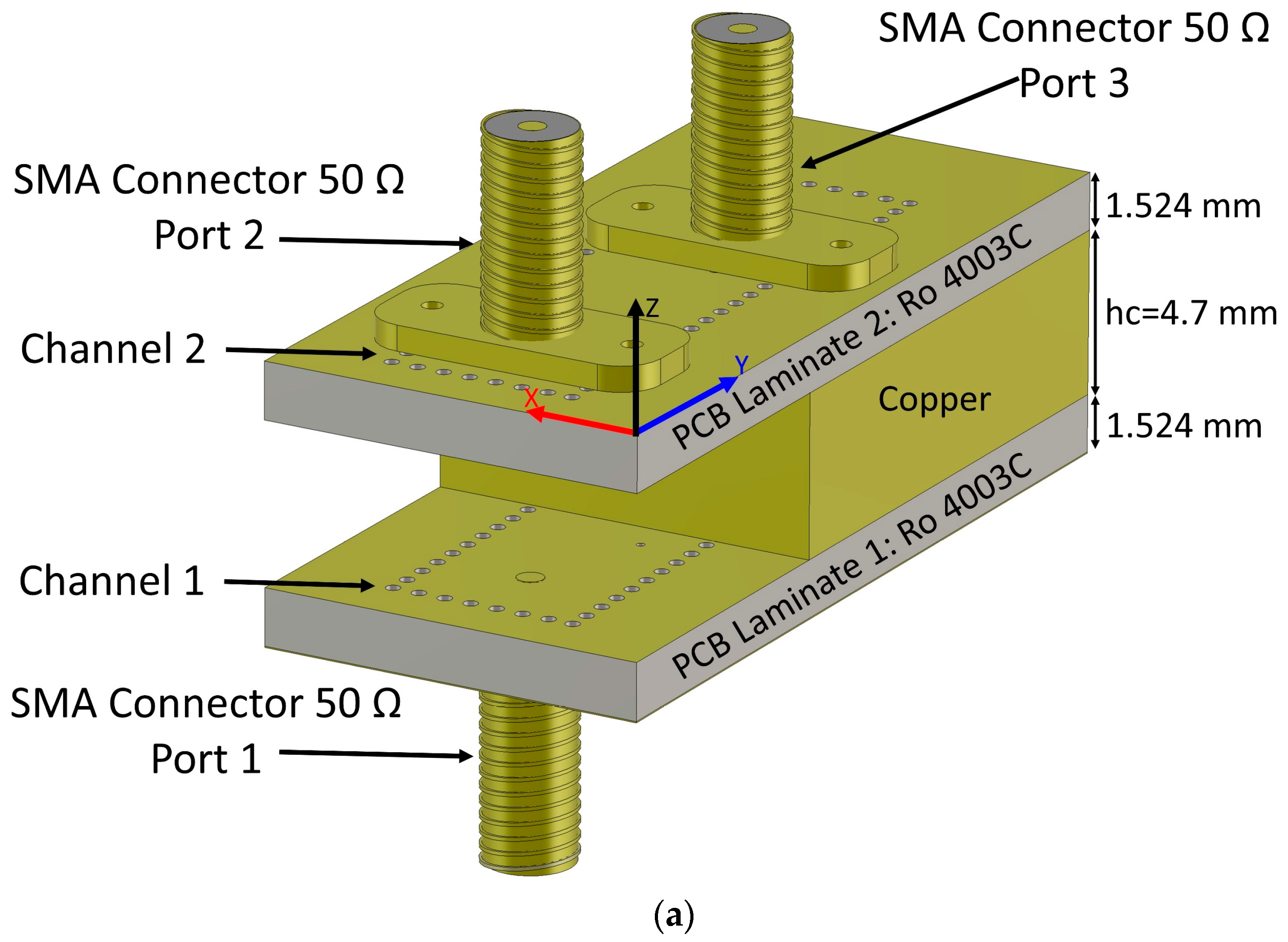
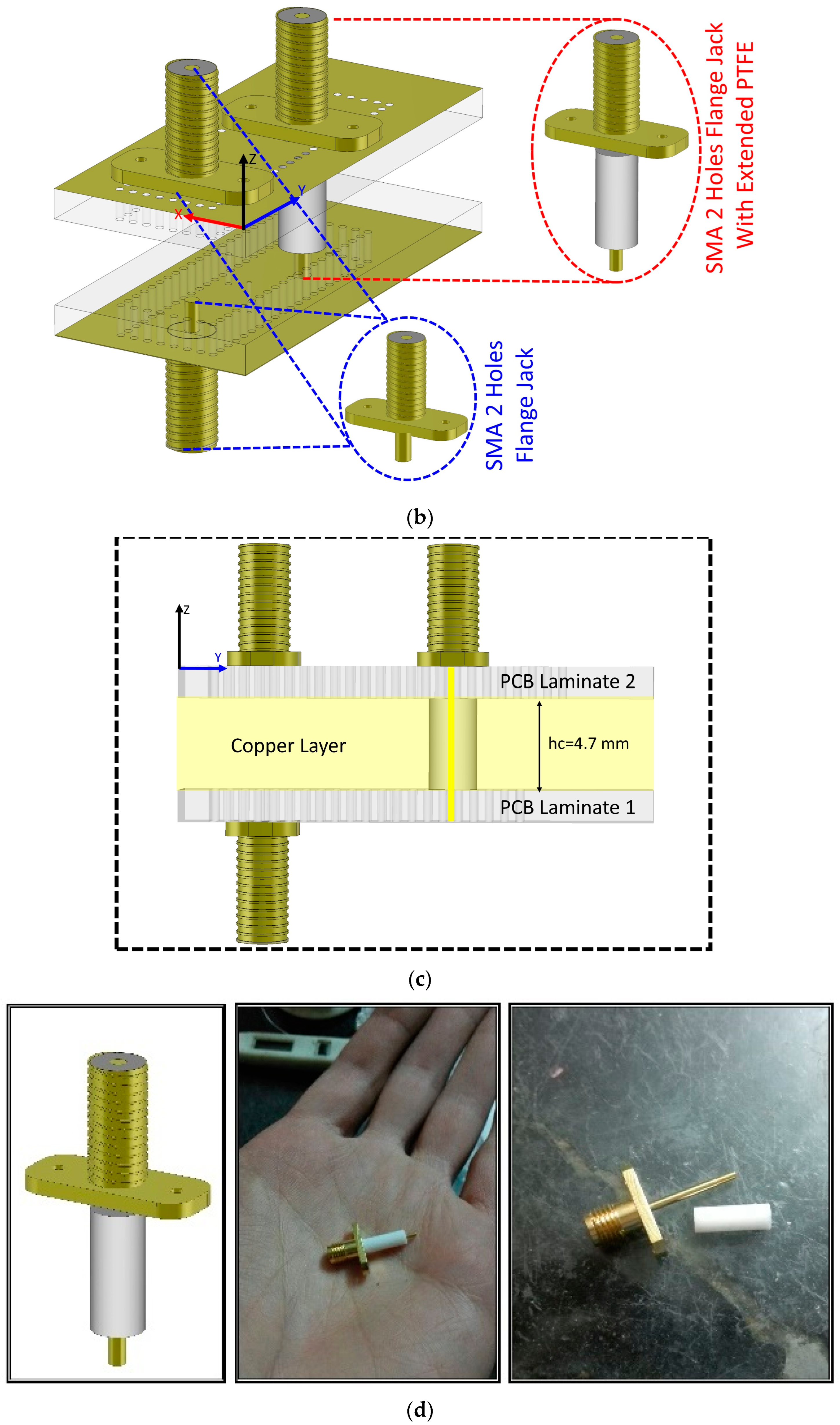






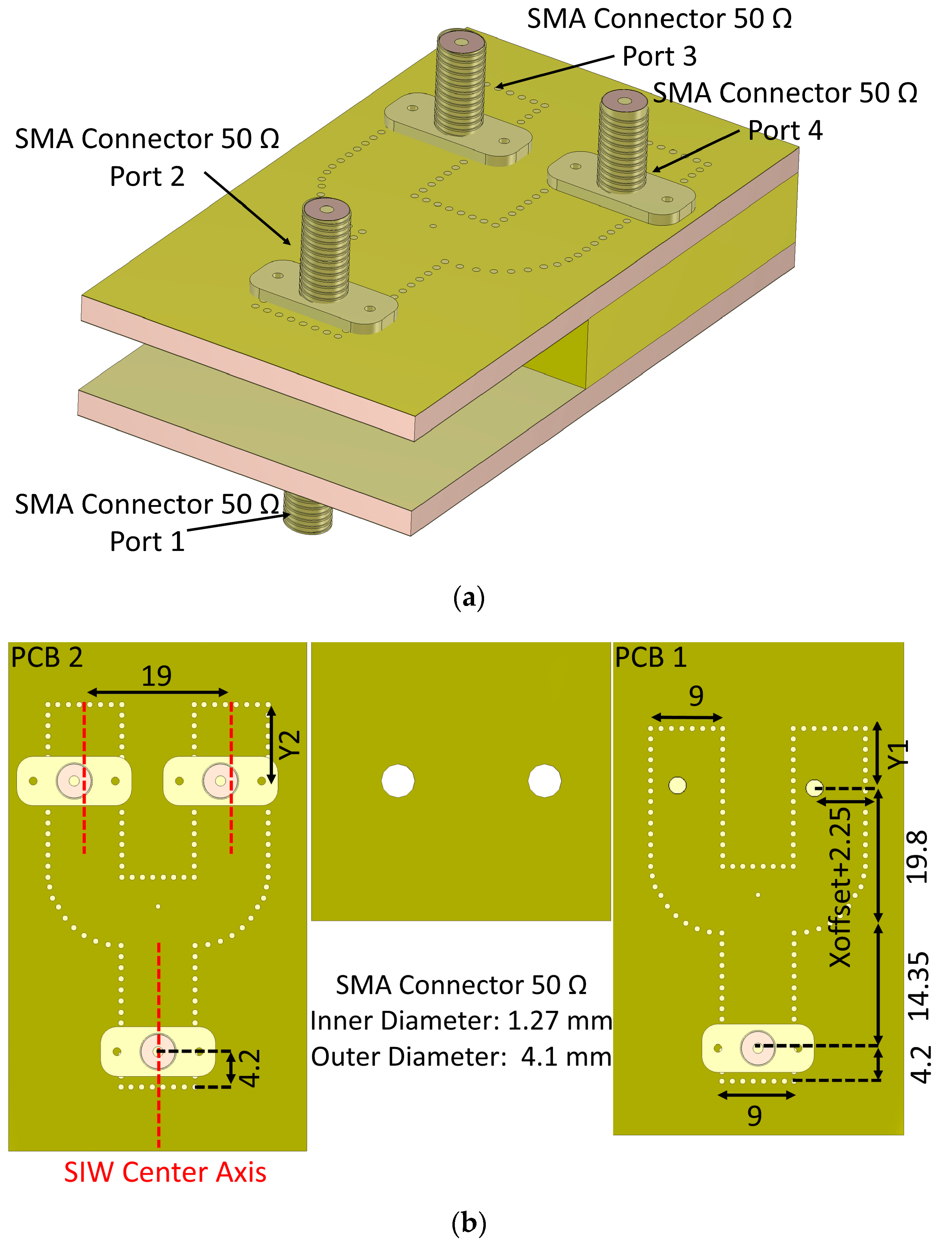

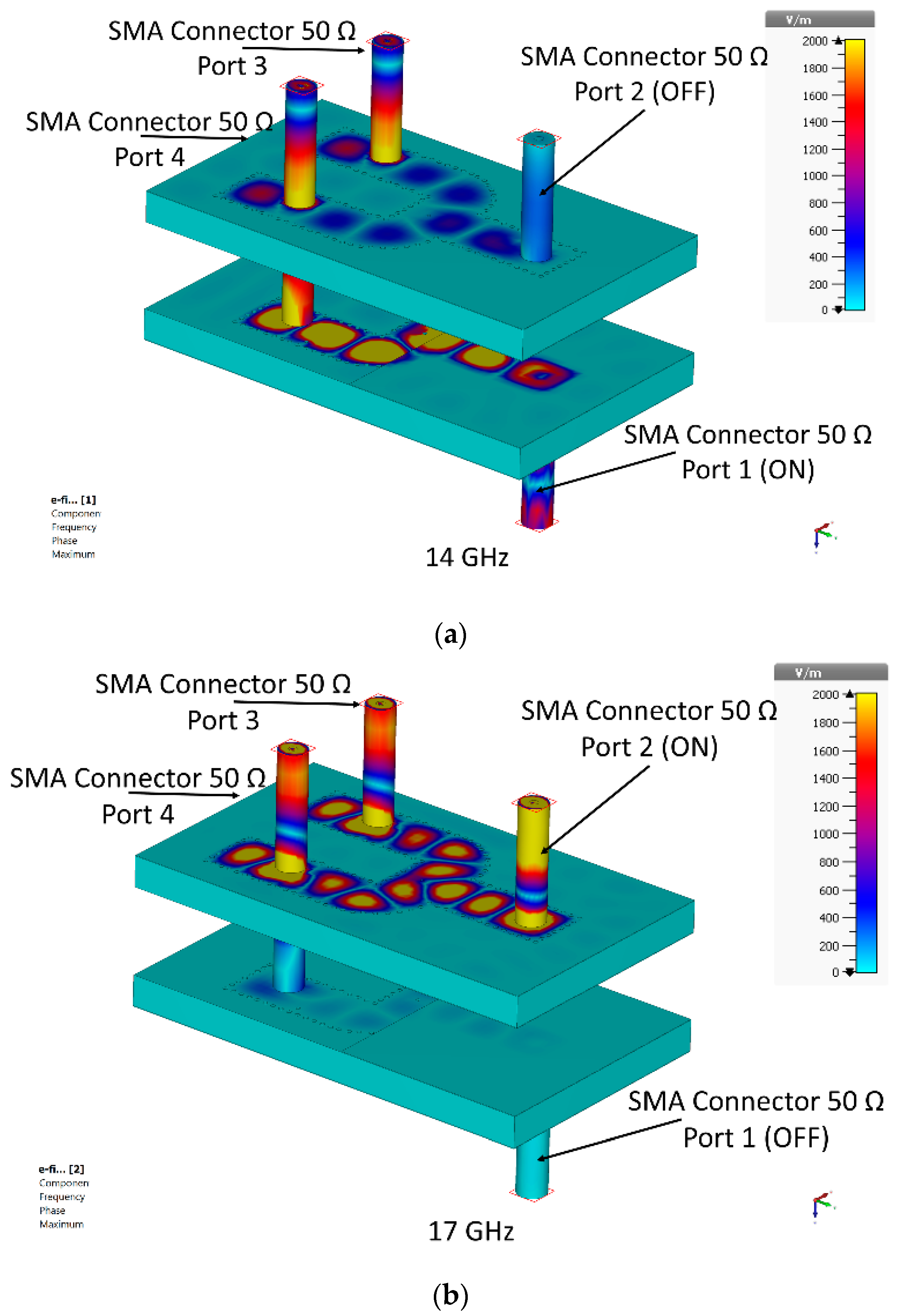

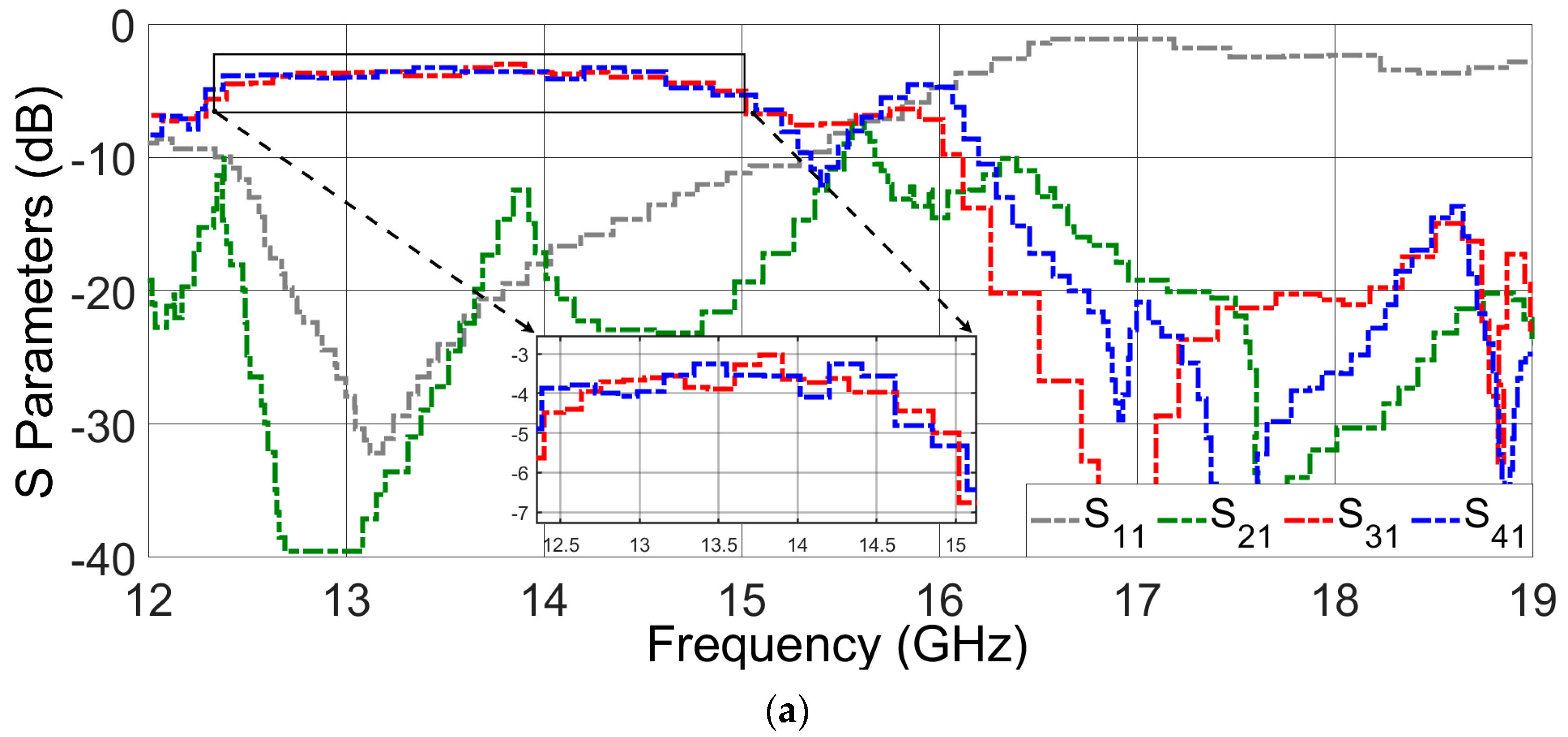
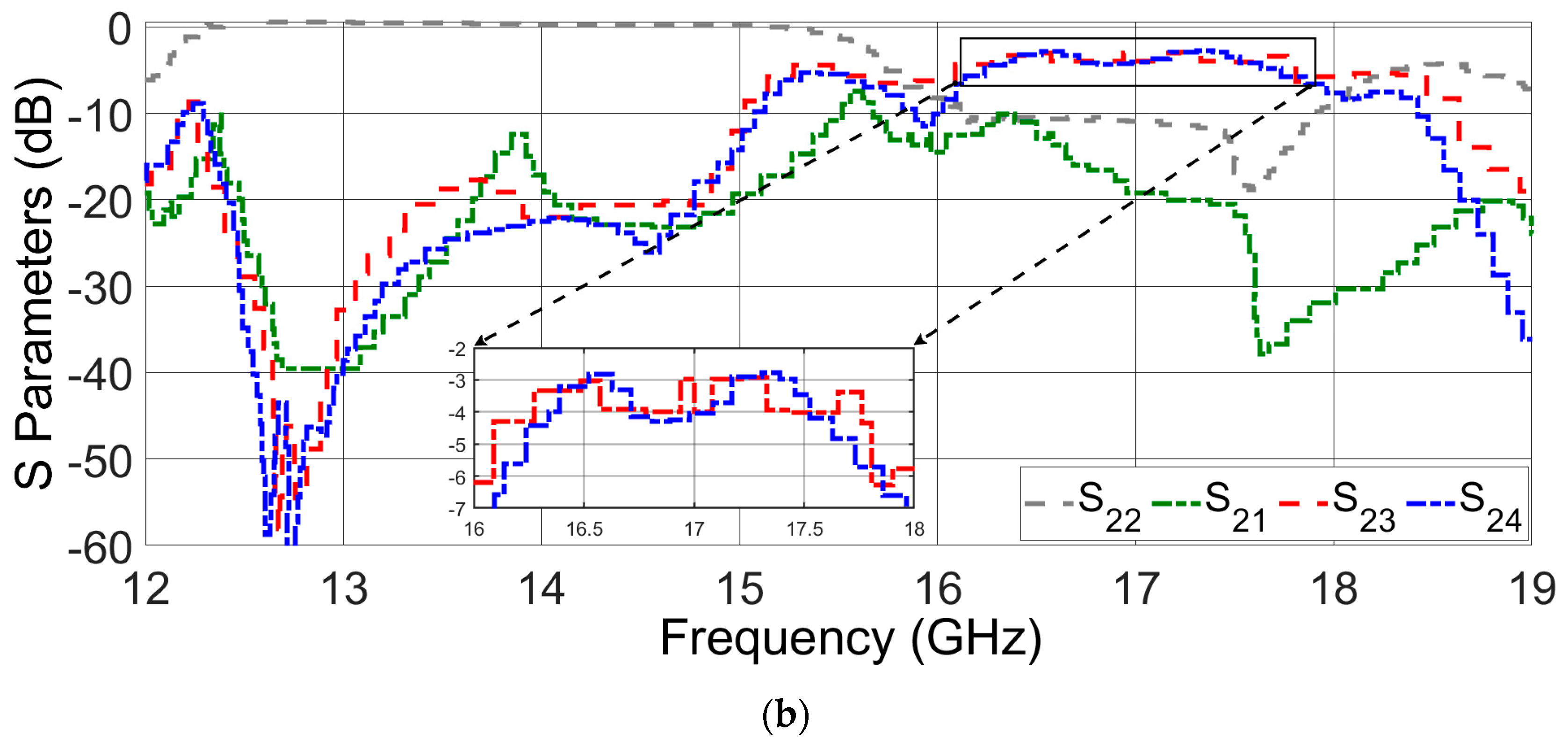

| Ref. | Center Frequency (GHz) | Fractional Bandwidth (%) | Insertion Losses (dB) | Return Losses (dB) | Isolation (dB) | Structure Technology |
|---|---|---|---|---|---|---|
| [46] | 28.2/29.2 | >2.3/>2.2 | 0.9/0.9 | 13/13 | 55 | Waveguide |
| [51] | 73.5/83.5 | >6.8/>6 | Not Given | 13/13 | 50 | Waveguide |
| [52] | 2.45/2.98 | <10/<10 | 1.6/1.9 | 19.2/15.3 | 24 | Microstrip |
| [53] | 1.8/2.4 | 4.4/2.7 | 5.6/7 | Not Given | 22 | Microstrip |
| [54] | 19.8/29.7 | 6/4.7 | 1.3/1.3 | 10/10 | 25 | SIW |
| This Work | 14.4/17.4 | 19.4/9.2 | 1.5/1.5 | 10/10 | 15–40 | SIW |
Disclaimer/Publisher’s Note: The statements, opinions and data contained in all publications are solely those of the individual author(s) and contributor(s) and not of MDPI and/or the editor(s). MDPI and/or the editor(s) disclaim responsibility for any injury to people or property resulting from any ideas, methods, instructions or products referred to in the content. |
© 2023 by the authors. Licensee MDPI, Basel, Switzerland. This article is an open access article distributed under the terms and conditions of the Creative Commons Attribution (CC BY) license (https://creativecommons.org/licenses/by/4.0/).
Share and Cite
Karami, F.; Boutayeb, H.; Amn-e-Elahi, A.; Talbi, L.; Ghayekhloo, A. Analysis and Design of a Diplexing Power Divider for Ku-Band Satellite Applications. Sensors 2023, 23, 8726. https://doi.org/10.3390/s23218726
Karami F, Boutayeb H, Amn-e-Elahi A, Talbi L, Ghayekhloo A. Analysis and Design of a Diplexing Power Divider for Ku-Band Satellite Applications. Sensors. 2023; 23(21):8726. https://doi.org/10.3390/s23218726
Chicago/Turabian StyleKarami, Farzad, Halim Boutayeb, Ali Amn-e-Elahi, Larbi Talbi, and Alireza Ghayekhloo. 2023. "Analysis and Design of a Diplexing Power Divider for Ku-Band Satellite Applications" Sensors 23, no. 21: 8726. https://doi.org/10.3390/s23218726
APA StyleKarami, F., Boutayeb, H., Amn-e-Elahi, A., Talbi, L., & Ghayekhloo, A. (2023). Analysis and Design of a Diplexing Power Divider for Ku-Band Satellite Applications. Sensors, 23(21), 8726. https://doi.org/10.3390/s23218726










